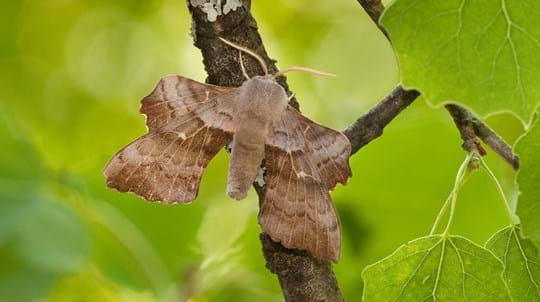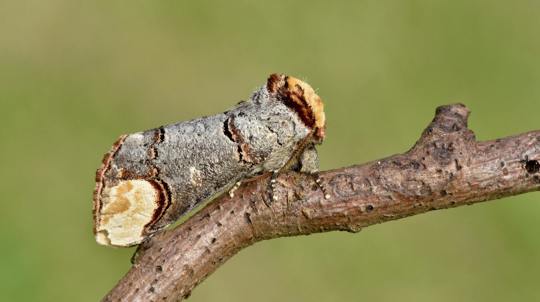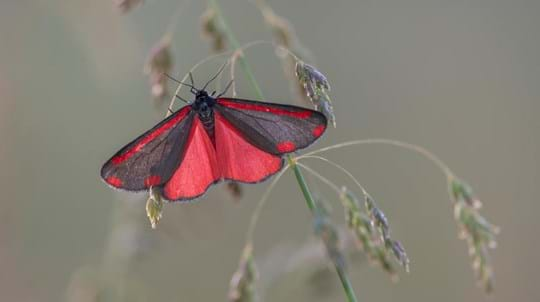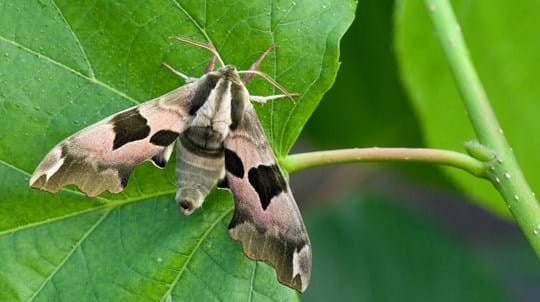
Nature's Calendar
Help monitor the effects of climate change on wildlife near you. Your records contribute to a growing body of evidence on global warming.
Add your wildlife recordings
Digital content editor
We have over a thousand moths in the UK! These fluttering insects perform an important role in our environment. But what fuels their activity?
Take a deeper look at what moths eat during their life cycle and how threats to moths affect this.
The majority of moths go through a similar life cycle.
What a moth feeds on comes down to the stage of its life cycle.
Caterpillars (larvae) can feed on leaves, flowers, stems and roots. They have a labrum and mandibles that help them eat this solid material. The labrum is like an upper lip that holds the plant matter in position while the mandibles grasp and cut it.
The type of plant material that the caterpillars eat depends on the species. Some may be particular about their food source, while others are generalist eaters. They eat the outer layer of vegetation or, like the pea moth, eat the inside of plants. So it is best to shell your pea bean harvest carefully!
The oak processionary moth and pine processionary moth can strip a tree clean of leaves or needles, leaving the tree vulnerable. These are species that have been unintentionally introduced to the UK.
Underwater caterpillars feed on pondweed and waterweed. This aquatic species of moth, found in the UK, is called the water veneer (Acentria ephemerella).
Fungi and lichens
Some moths in a family called Tineidae feed on fungi, lichens and other organic matter, such as rotting wood. Some moths, like the young gypsy moth, prefer to feed on leaves that are infected with fungal disease.
Moth larvae can also eat fabric. Only two species do this, namely the common clothes moth and the case-bearing clothes moth. Clothes moths eat natural fibres such as cotton, velvet, silk, wool, fur, leather and linen.
When a caterpillar turns into a moth, its mandibles are replaced by a straw-like tube that coils up under the head when it isn't in use. When it's time to feed it coils out like a party blower and sucks up liquid.
Most moths have wings which give them the advantage of being able to lift off and scour a larger area for food. This food can come in the form of nectar from flowers, juices from rotting and fresh fruit or sap.
Some moths do not feed at all because they survive for a number of days. During that time they mate and lay eggs.
The life cycles of moths are carefully synchronised with those of their food plants. Mild winters can lead to flowers blooming and insects like moths emerging earlier than normal. This in turn has an impact on their predators (birds and bats) that rely on them as part of their diet.
Help us track the effects of weather and climate change on wildlife near you by joining Nature's Calendar. From leaf buds bursting to blackberries ripening, let us know what's happening near you and contribute to a biological record dating back to 1736.

Help monitor the effects of climate change on wildlife near you. Your records contribute to a growing body of evidence on global warming.
Add your wildlife recordingsThe State of Britain's Larger Moths 2021 suggests that larger moths have decreased in abundance and that, in general, ecologically specialised moths are not doing as well as generalist species. Those that were once common in gardens are in decline and include stout dart, garden tiger, blood-vein, white ermine, V-moth, golden plusia and garden dart. Moth species common in farmland and woodland are also experiencing similar losses, which in turn impacts food chains.
Moths are currently under threat and in decline due to:
The loss of veteran trees, wet areas, and traditional coppicing practices can lead to declines of moth species.
The expansion, protection, restoration, and creation of habitats with trees can go a long way to supporting moths. Trees planted together act as a sheltered corridor that can offer safe passage across farmland. Individual trees play their part too by providing places to lay eggs, leafy food and a supply of sugary nectar.
You can do your bit for moths too by planting oak, hornbeam, hawthorn, apple, cherry, dogwood, birch and willow in your garden. You can also help moths and other species by tracking what's happening to nature near you.

Trees woods and wildlife
Discover the moth species that live in woodland, and how they use their camouflage skills to blend in with tree bark and leaves.

Blog
Amy Lewis • 02 Jun 2021

Blog
Amy Lewis • 23 Apr 2021

Blog
Amy Lewis • 21 Jun 2021

Blog
Charlotte Varela • 08 Jul 2024